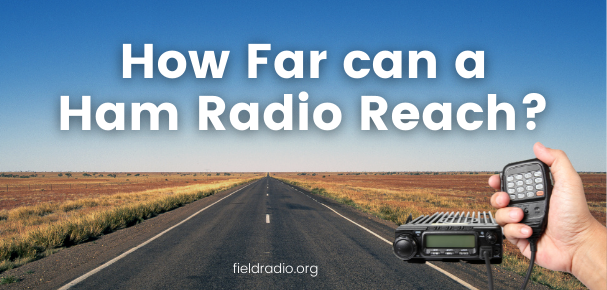Ham radio operators, especially those who are just entering the hobby, often toy with the idea of using one radio for communicating with all other types of radios. It is more convenient after all.
Many families often keep GMRS radios on hand to communicate in emergencies or “test the waters” of radio communication.
It is far more convenient for professional hams to talk to their GMRS-operating loved ones by switching to GMRS frequencies on their ham radio stations.
But then it is also more convenient (and cheaper!) to board a plane without buying a ticket. And we don’t do that. Do we?
So, as convenient as it may seem, using a Ham radio to communicate with GMRS might not be the best of ideas. You’ll know why in a bit.
Also, talking to CB radios may not be an option either. Just putting it out there in case you are thinking “if not GMRS, I’ll transmit to CB”.
While certain Ham radios might be able to transmit on GMRS frequencies, doing so is considered illegal unless you have a life or death emergency. You can, however, listen to GMRS frequencies on your Ham station.
What is GMRS Radio?
The GMRS or General Mobile Radio Service is part of the radio spectrum that operates on frequencies ranging from 462 MHz to 467 MHz.
Operating on high frequencies, GMRS radio is used for short-distance two-way communications since the high-frequency signals are more likely to be distorted over longer ranges.
The GMRS radio is designed especially for families that want to keep the option of radio communications on hand without going knee-deep into the technicalities of radio communication.
Despite being fairly simple, FCC still regulates the use of GMRS radio. Individuals who wish to use this service are required to acquire a license before being allowed to operate a GMRS radio.
Now that we know what GMRS is, let’s see how it compares with our trusty old Ham radio
Ham Radio and GMRS: The Similarities and The Differences
Let’s talk about the similarities first before diving into the differences.
The similarities between Ham vs GMRS radios begin with their being a part of the radio spectrum. And that’s pretty much where they end.
Now, before I offend any of the Hams here by comparing GMRS with Ham radio and talking about their similarities, let me quickly jump into the differences.
At this point, you might be thinking I have missed one more similarity between Ham and GMRS radios. Both of them are licensed. Isn’t that a similarity? Of course, it is. But the way the use of both radios is licensed makes this more of a difference.
Acquiring a GMRS license is as simple as paying the license fee, probably filling up a form or two, and you are good to go. Ham radio license acquisition, on the other hand, is a whole different ball game.
There are three classes of Ham radio license, and each class has a different exam that you have to pass to get your license. There’s nothing like that with GMRS. Got the money? Get the license.
However, the biggest difference between Ham and GMRS radios is that of purpose. While GMRS is dedicated to connecting families in case of emergencies, Ham is largely practiced by passionate radio enthusiasts as a hobby.
GMRS radio users use their radio for what it is, a radio. Hams, on the other hand, live and breathe amateur radio. Some might even love their stations more than they love their kids.
Both radios operate at different frequencies as well. GMRS operates at 462 to 467 MHz, while Ham radio operates on various spectrums known as bands. The most popular of these Ham Radio frequencies range from 144 to 148 MHz and 420 to 450 MHz on the 2m and 70 cm bands, respectively.
Another difference that’s worth stating here is that GMRS is short-distance. It is normally used to communicate with people across town, at best. Ham radio, however, can be used both as short-distance and long-distance radio.
You can use it to talk to your friend next door or (with the use of Ham Radio Repeaters) you can talk to people right across the continent!
Let’s address the elephant in the room.
Can You Use Ham Radio on GMRS Frequencies?
Yes, you can. But that’s not the question here. The question here is, should you be using Ham radio on GMRS frequencies? And the answer to that is no.
Technically, most Ham radios can transmit on frequencies outside the Ham radio spectrums as well. So, you might be able to key in to GMRS frequencies with your HT.
However, the law does not permit you to do that.
The FCC has strict regulations regarding the devices that can be used to transmit on the GMRS frequencies. If your Ham radio goes against these regulations (which it probably does), you would be breaking the law by transmitting on GMRS frequencies.
Additionally, as you know from above, GMRS transmission requires a license. And contrary to what most Hams believe (and boast about), a Ham radio license does not supersede the GMRS license. In other words, having a Ham radio license does not automatically make you eligible for transmitting on GMRS frequencies.
You can, however, listen to GMRS frequencies using your Ham radio. And in case there is a life and death emergency, and you really need to talk to someone who has a GMRS, I think the FCC might be able to turn the other cheek.
Final Word
Your Ham radio might be capable of transmitting on GMRS frequencies.
But just like you don’t pick whatever you like from a shop and walk out without paying just because you can, you cannot transmit on GMRS frequencies just because your radio can.
It is illegal. You would be breaking the law while doing so, which can lead you to paying fines or, if your luck has maxed out, criminal prosecution.
So, it is better to keep a GMRS radio on hand besides your Ham radio to stay connected with your GMRS and Ham buddies simultaneously.

I have been passionate about the world of communications in its various forms for most of my life. Ever since I first found an old ham radio stashed away in my uncle’s attic, I have had a fascination with this classic technology.
Having the ability to communicate with people without the need to rely on telephone lines or networks is an empowering feeling which I believe everyone should have at least a basic knowledge of. Becuase who knows when you might need it?
I setup fieldradio.org with this passion in mind, to help inform people about the amazing possibilities of amateur radio and I’m on a quest to help educate as many budding operators as possible.
I hope you enjoy our content. Come and say hi, via our contact form


